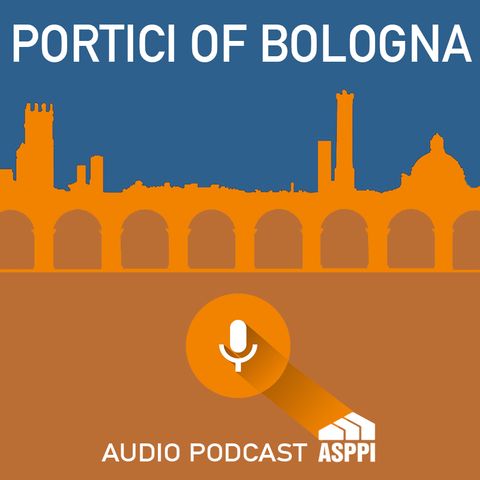Portici of Bologna. Via Farini, Piazza Cavour (English)

Scarica e ascolta ovunque
Scarica i tuoi episodi preferiti e goditi l'ascolto, ovunque tu sia! Iscriviti o accedi ora per ascoltare offline.
Descrizione
The portico of Via Farini is in the most elegant part of the historic centre, famous for its luxury shops and for the struscio (the Italian word which the locals...
mostra di piùThis wide curved street is the outcome of the 1860 plan of engineer Coriolano Monti to connect four very old streets: Via de' Libri, Borgo Salamo, Ponte di Ferro, Miola. Once finished the street was named after politician Luigi Carlo Farini who had worked at the annexation of this part of Italy, Emilia to the Regno d'Italia (the Italian Kingdom).
To create the new street many steep steps, narrow arched side streets with dark small shops had had to be demolished with also the more noble buildings needing to be "straightened out" and in some cases with façades "moved back" to create a continuous front. Monti's Neo-Renaissance architecture aligned and unified the porticoed buildings of the new street, adapting the official National Unity Imperial style to the distinctive city context of Bologna, achieved of course, not without complaints by some angry citizens!
Along Via Farini are some of the most important and interesting buildings of the city such as Casa Saraceni, built at the beginning of the 1500s on the foundations of one of the 1200s, as stated in the plaque in vicolo San Damiano. A palazzo that became the seat for two ambassadors from the Veneto of pope Julius II after the Bentivoglio family was made to leave the city in 1510. The street has one side of the Archiginnasio now the Council Library but originally the seat of the University of Bologna until 1803 when Napoleon will have it moved to Palazzo Poggi, in Via Zamboni. In 1842 in the building's Hall of Mathematical Sciences (Sala delle Scienze Matematiche) composer Gaetano Donizetti directed the Stabat Mater by Gioacchino Rossini.
Under its portico on the corner between piazza Galvani and via Farini is the renowned Bar Zanarini where the locals like to go and enjoy refreshments after their shopping or the struscio.
Buildings of notice are the eclectic Palazzo of the Cassa di Risparmio bank building by architect Giuseppe Mengoni with an opulent portico decorated by ornate -still working! metal lamps, or, on the other side of the street, Palazzo Guidotti with a portico with original capitals of the 1500s along Via Farini and friezes with engraved profiles of important people on its side in Piazza Cavour, there is even that of the architect of the building, Coriolano Monti.
Piazza Cavour was planned to create an elegant square for government and institutional buildings, particularly banks. The urban plan by Monti made porticoes mandatory and to be typologically similar. The square was opened in 1867 and eventually designed as a garden in 1870, with allotted areas for flowerbeds connected by pathways, all surrounded by a fence. The water sprinkling from the fountain is from the restored branch of the Roman aqueduct and the bust of Cavour, first Italian Prime Minister, was placed in the square in 1892.
The most interesting building here is the Bologna headquarters of the Banca d'Italia, by architect Antonio Cipolla, completed in 1865. It's has a Neo-Renaissance façade and all the ceilings of the portico frescoed by Gaetano Lodi who on each vaulted section painted historical events, geographical explorations, discoveries, and cities with their coat of arms.
Last to be mentioned is Palazzo Pizzardi now seat of the Tribunal, was completely refurbished in 1868 by architect Antonio Zannoni, who had to dramatically re-organize the side on via Farini as the building had to be moved back with a portico to fit into the new street alignment complying to the new urban rules.
Later, in 1893, along via Farini, on the west side of the Cassa di Risparmio building, a new square dedicated to economist Marco Minghetti was opened. This was the final touch which together with Piazza Cavour, created in this part of town the idea of a garden-city.
By Antonella Merletto Architectural historian and Official Tour Guide.
Antonella has a degree in Architecture, a post-degree specialization in Ancient Greek and Roman Architecture and a PhD in Ancient Architecture. Antonella is British-Italian and is bilingual. She teaches History of Art, History of Architecture and Archaeology in various American Universities in Rome and is an Official Tour Guide.
Informazioni
| Autore | ASPPI |
| Organizzazione | ASPPI |
| Sito | - |
| Tag |
Copyright 2024 - Spreaker Inc. an iHeartMedia Company

Commenti